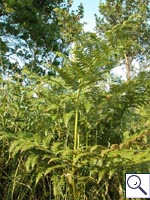|
||||||
|
PTERIDIUM. Bracken. [Dennstaedtiaceae] |
|
|
Bracken (P. aquilinum), is the only species of Pteridium recorded in Britain. It is a native species. The BSBI provide a downloadable plant crib for Pteridum aquilinum agg. Nine British miners are reco0rded on Pteridium. A key to the European miners recorded on Pteridium is provided in Bladmineerders van Europa. |
 Bracken Pteridium aquilinum |
Key for the identification of the known mines of British |
1# >Leaf / Stem-miner: In leaf stems and fronds (Ackland in Chandler, 1978: 227). |
|
Chirosia cinerosa (Zetterstedt, 1845) [Diptera: Anthomyiidae]. |
1a > Leaf- and stem-mine: Mine in the lowest part of the petiole, not in the pinnulae-bearing part of the rachis. Often several larvae together. Mined leaves are stunted, often incompletely rolled out. Puparium in the mine or in the ground. See de Meijere (1911a) and Brown and McGavin (1982) for details of the biology. |
|
Chirosia crassiseta Stein, 1908 [Diptera: Anthomyiidae]. |
1b > Stem-miner: Oviposition normally on one of the lower secondary pinnulae. The larva enters a vein and from there descends as a borer in the rachis. Often several larvae together. Attacked leaves can be recognised because the leaf is stunted, often remaining partly unfolded. Pupation in the mine or in the ground. See Brown and McGavin (1982) for details of the biology. |
|
Chirosia albitarsis (Zetterstedt, 1845) [Diptera: Anthomyiidae]. |
1c > Leaf-miner: The larva mines the lower surface of rachis, close to the lesf tip. The upper surface is left intact, resulting in growth disturbance that causes the leaf tip to strongly curl downwards. Larva generally solitary. Pupation within the roll. The miner causes the pinna tip to curl downwards. |
|
Chirosia grossicauda (Strobl, 1899) [Diptera: Anthomyiidae]. |
1d > Leaf-miner: Large full depth blotch, covering the entire distal part of a pinnula. The mine begins near the top, where an elliptic egg shell is attached to the underside of the rachis. Larva solitary. The mine contains much frass. An upperside blotch at the tip of a pinna lobe. |
|
Chirosia histricina Rondani, 1866 [Diptera: Anthomyiidae]. |
1e > Leaf-miner: Ovipisition on the upper part of the rachis of an unrolling leaf. The larva bores into the rachis, causing the distal part of the leaf to become stunted and finally necrotic. Often several larvae in a mine. Pupation outside the mine (Brown and McGavin, 1982a). |
|
Chirosia nigripes Bezzi, 1895. [Diptera: Anthomyiidae]. |
1f > Leaf-miner: Larva forming short linear mine in single section of a frond. Pupation external (Spencer, 1972b: 58). Large, very transparant blotch, with primary and secondary feeding lines. In the centre a concentration of black frass. Mines can coalesce, and then contain several larvae. At the start of the mine, at the leaf underside, a white egg shell. However, the larva can leave its mine and restart elsewehere, therefore mines without an egg shell may occur as well. A small marginal upper surface gallery in a single section of frond. |
|
Phytoliriomyza hilarella (Zetterstedt, 1848) [Diptera: Agromyzidae]. |
1g > Leaf-miner: A short linear mine at edge of frond segment. Pupation external. Mines practically identical to those of P. hilerella which may be distinguished from P. pteridii by the male genitalia. Puparium brownish-orange |
|
Phytoliriomyza pteridii Spencer, 1973 [Diptera: Agromyzidae]. |
1h > Leaf-miner: Full-depth corridor or blotch, often positioned along the leaf margin. In the first part much, brown-black, fine-grained frass, later parts of the mine almost free from frass. After hibernation the larva lives free in an untidy case of silk, covered with remants of sori. |
|
Psychoides verhuella Bruand, 1853 [Lepidoptera: Tineidae]. |
| Last updated 20-Feb-2020 Brian Pitkin | ||
